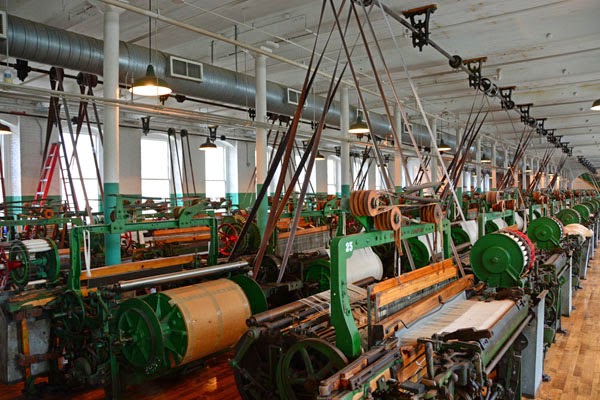Lowell, Massachusetts changed how Americans lived and worked in the early 1800s by bringing together abundant water power from the Merrimack River, capital to build large textile mills and young women from New England farm families to supply the labor needed to operate the looms that mass produced cotton cloth, a product in great demand. Lowell became America's first industrial city! This sparked the transformation of America's economy from agriculture to manufacturing.
Francis Cabot Lowell in 1814 journeyed to England to inspect working textile mills and study the operation and construction of their power looms. It is said that Lowell memorized the details of the various parts of the looms and the mechanical systems that powered them. On his return to Massachusetts, Lowell and a mechanic were able to replicate the machinery and set up a working water-powered mill in Waltham, MA with the help of investors. This venture proved very profitable and even after Lowell's death in 1817, plans for the establishment of much larger mills led to the creation of the town of Lowell, MA in 1821 with the hand digging of a large canal system taking the 32 foot drop in one mile of Pawtucket Falls of the Merrimack River to a number of water-powered mills located along the canals. Company owned boardinghouses were built for the "Mill Girls", the female labor force and regulations were enforced for their moral and physical wellbeing so that the evils of Britain's mill towns would not be repeated here.
By 1850 Lowell had experienced huge growth and was the second largest city in Massachusetts with a population of 33,000. The ten mill complexes employed more than 10,000 men and women. Most workers were young single Yankee women from farms and rural communities where there were poor to no working opportunities. The mills in Lowell paid monthly cash wages, furnished comfortable room and board and in this new urban environment, offered an array of previously unknown cultural opportunities.
12 to 14 hour work days in the mills 6 days a week were common and the boardinghouses had strict curfews and codes of conduct. Church attendance was required. Work was hard and even unhealthy. In the 1830s and 1840s, females workers went on strike protesting working conditions, wage cuts and their demands for a 10 hour day. Usually these strikes and work stoppages were unsuccessful. As competition between the mills increased, prices fell and owners reduced the worker's wages!
Irish immigrants began arriving in Lowell in the 1840s to escape poverty and famine in Ireland, by finding jobs in the mills as laborers and machinists. These were the first of many immigrants to come to Lowell, especially after the Civil War, to work in the mills. French-Canadians, Greeks, Poles, Portuguese, Russian Jews, Armenians and many other ethnic groups settled in Lowell forming ethnic neighborhoods like Little Canada, Chapel Hill with Irish and Portuguese, Jewish section, several Polish enclaves and The Acre with Irish and Greek. These neighborhoods had their own schools and churches, newspapers and social clubs to support newly arrived immigrants. Over 10,000 power looms converting raw cotton from the South into nearly a million yards of cloth per week were operating in the ten Lowell mills!
Lowell took the technological lead in the mid-1800s converting from waterwheels to turbines and steam. But by the late 1800s, Lowell began to suffer from increased competition from newer mills, mills opening in the South with cheaper labor and lack of reinvestment in its mills by corporate owners. In the 1920s many Lowell mills became unprofitable and closed, causing massive unemployment. World War II restarted mill operations in Lowell but by the mid-1950s the last of the original mills in Lowell closed down.
In the 1960s and 70s, major efforts were underway to form partnerships between government, educational institutions, urban planners, historians and politicians to create "a new kind of historical park, a living museum
based on the city's distinctive industrial, ethnic and architectural heritage." In 1978, the U.S. Congress passed legislation forming Lowell National Historic Park, becoming the catalyst for Lowell's economic and cultural revitalization. Walking around downtown Lowell, it becomes obvious that the city is reinvigorated with the repurposing of most of the old mill buildings into offices and residential communities, sidewalk cafes and coffee houses, art galleries, many professional offices occupying restored architecturally significant properties and well kept homes and businesses.
Visiting this unusual urban park starts at the Visitor Center located in a handsome former mill building with one of the power canals in front. There is a 20 minute orientation film shown every 1/2 hour that is excellent, many displays including the fascinating story of Charles Dicken's visit to Lowell in 1842 to see the mills and the workers. The Park runs several free historic electric trolleys that bring the visitor from the Visitor Center to the Boott Cotton Mills Museum and Mill Girls and Immigrants Exhibit.
Boott Cotton Mills complex is now a residential community in the beautful old Boott Mill complex where the Park retained the building which housed a 1920s vintage weave room with 80 operating looms manufacturing cloth. The roar and vibration as the machinery operates is impressive! The looms themselves are amazing pieces of antique machinery with multiple belts, wheels and shuttles flying back and forth in the process of making cloth. A museum is on the 2nd floor showing much more about the worker's life in the mills along with the competitive forces that ultimately closed the mills and moved cloth production to other areas and many other countries. Exploitation of the workers and labor disputes are discussed thoroughly.
 |
| Anyone for Pizza? |
















No comments:
Post a Comment